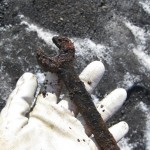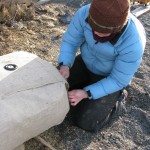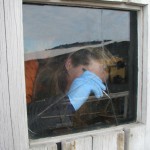Glove, sweet glove
When people find out that I work in Antarctica, one of the first questions they usually ask is how I manage to stay warm while living and working outside in such cold temperatures. With the many layers of wool, down and synthetic clothing we wear, it is actually fairly easy to keep warm in even the coldest and windiest of conditions, with the exception of our hands. They are certainly the most common victims of frostbite, and while many people who work in Antarctica can rely on thick gloves or mittens to protect their hands from the cold, the delicate and often fiddly nature of conservation work means that bulky, awkward gloves aren’t often an option for us. As such, cold hands are just an accepted part of our everyday reality, but that certainly doesn’t stop us from trying to come up with the best possible glove/mitten solution for whatever type of work we are doing at the moment. Just as chefs have their various knives and golfers their different clubs, Antarctic conservators each have a complete stable of glove options for their various tasks, and here’s what I tend to rely on:
For general use, I wear two pairs of fleece mittens handmade by a friend in Banff. Though they are a warm and comfy option, I must admit that they aren’t overly windproof and don’t have any good grip, so aren’t really great to wear for carrying things. Also, should I need to do anything that requires the dexterous use of fingers, such as writing, changing camera lenses, or most conservation tasks, I need to take them off thereby putting my hands them at the mercy of the elements. The solution to this problem is simply to wear a thin pair of fleece gloves underneath my mitts if I know I’m going to be tackling tasks that I need my fingers for. I also have a pair of mitts that have tips that fold back to expose fingerless gloves underneath – the best of both worlds, really. For heavy lifting or snow shovelling, there’s nothing more practical than insulated leather work gloves, and for extremely cold tasks like riding skidoos, we rely on heavy duty windproof mitts with double fleece liners.
Whenever we handle artifacts or use solvents of any kind we must wear nitrile gloves; luckily we can fit a thin pair of polypropylene glove liners underneath them. This combo is still the coldest of all, so we often shove a handwarmer (like the ones you might use on the ski hill) inside each of our gloves, though this still only gives us about fifteen minutes of working time before the whole lot has to get stuffed inside other mittens to warm up again. We have even more gloves that we use for especially dirty tasks like archaeological excavation or refuelling of generators – I prefer to use insulated gardening-type gloves,. And sometimes, there’s simply no glove that will do the trick and you must simply endure the cold with your bare fingers for as long as possible.
And finally, aside from my everyday mitts, my favourite gloves have to be the fleece ones that I’ve modified by adding a grippy panel to one finger, which lets me easily turn the pages of my book while lying in my sleeping bag at night without getting cold hands!
- work gloves for grippy tasks
- waterproof gloves for excavation
- sometimes only bare hands will do
- polypropylene gloves fit underneath nitrile gloves!
- it’s pretty much impossible to wield a scalpel wearing gloves
- conservation wearing my favourite mitts
- a bit of both









